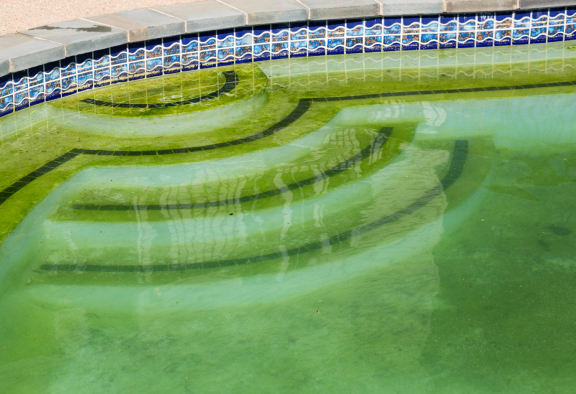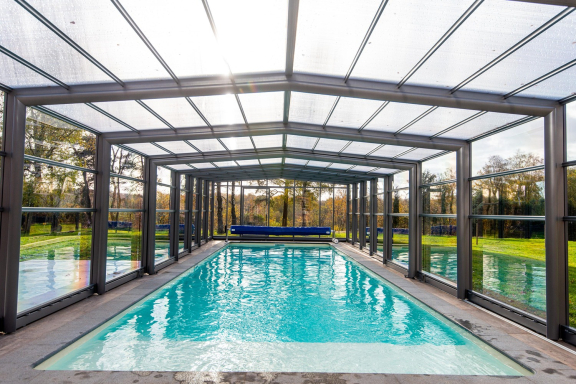My pool water is green – what should I do?
If there's one thing you really don't want, it's green pool water. However, despite all your pool maintenance, the colour of your water has changed and is not particularly inviting. How do you explain this phenomenon and what should you do to recover a clear pool?
Why is your pool water green?
If your pool water is green, there's no doubt about it: algae have developed in your pool. Indeed, algae can easily proliferate in pool water. Their appearance is generally caused by:
An imbalance in the water pH;
- Poor filter operation;
- An insufficient chlorine level;
- Insufficient pool and equipment cleaning;
- The temperature is too high.
Solving the problem of green pool water starts with rigorous cleaning and treatment. But it is also important to understand how the algae were able to develop. By determining the cause, you will solve the problem more effectively and avoid its reappearance in the future.
You should not use the pool while you are waiting to finish the treatment. Indeed, this green water is polluted and the bacteria it contains may cause irritation or infection.
How can you remedy green pool water?
It is important to rapidly solve the problem in order to avoid the proliferation of algae. Start by finding out what made it possible for the algae to develop and then carry out meticulous cleaning combined with a water treatment.
How do you treat green pool water?
Two treatment products will help you clean up green pool water: chlorine and algaecide. If your pool does not use chlorine, you will use peroxide or liquid active oxygen.
Chlorine and hydrogen peroxide already act as algaecides in addition to their anti-bacterial action. Therefore, a pool shock treatment will effectively disinfect the water.
Algaecide may be used as a preventive treatment. By regularly adding a dose to your pool, in addition to chlorine, you will limit the risks of seeing your water turn green. If it is too late, these products will complete the shock treatment.
The steps to clean up green water
How can you remedy green pool water? Here is the procedure to follow:
1. Vigorously brush the sides to dislodge the algae.
2. Use a skimmer net to remove surface algae.
3. Use a vacuum robot to remove sediment from the bottom of the pool.
4. Clean the skimmer, basket, nozzles and filter.
5. Perform a shock treatment to disinfect the water.
6. Add an algaecide to the pool water.
7. Use a flocculant to filter the finest particles more easily.
8. Run the filtration continuously until your water is clear again.
The green water should already improve after several hours of filtration. Depending on the quantity of algae, it may have to run for 24 to 48 hours to completely recover clear water. After the treatment and filtration, don't forget to test your water and rebalance the pH and chlorine levels, if necessary.

Why may your pool water stay green despite treatment?
You have cleaned your pool and have carried out a chlorine shock treatment, but your pool water is still greenish. Several reasons may explain the failure of your treatment. Once you have found the explanation, you will be able to carry out another shock treatment and full filtration to recover, this time around, clear water.
Faulty filtration
If the problem is not solved, it is possibly due to the filtration system. Carefully check that no parts are damaged or broken. If everything appears to be in order, wait a few hours after brushing the pool sides to allow all the sediment to settle to the bottom of the pool before filtering.
Incorrect stabiliser dosing
The stabiliser protects the chlorine from evaporating under the effect of the sun's UV rays. However, too much stabiliser reduces the effectiveness of the chlorine! If the shock treatment has not worked, it is perhaps because the stabiliser has lost its effectiveness.
Above 70 mg per litre of water, there is too much stabiliser (the ideal level is between 20 and 30 mg). The inconvenience is that the stabiliser does not dissolve in water. To reduce its level, you will therefore have to partially empty the pool and fill it again with fresh water. Winterising is the ideal time to check the quantity of stabiliser and adjust it.
Very high pH
For the chlorine in a shock treatment to act correctly, the pH of the pool must be stabilised between 7.0 and 7.2. If your pool remains green, check the pH level and adjust it if necessary, before carrying out the treatment.

How do you get rid of green foam from a pool?
Bathing may create foam that quickly dissipates. But how do you explain foam in a green pool that you cannot bathe in?
Green foam may simply be caused by an invasion of algae in the pool. Algae cling to the pool walls and create a foamy effect. It is therefore very important to brush the walls well to dislodge them.
Foam may also be caused by an algaecide that you have used to treat green water. In this case, don't worry: everything is normal and the foam will disappear with filtration.
Pool water that has turned green during the winter
Proper winterising should enable you to have clear water in the spring. Unfortunately, you may discover that your water has turned green. Once again, this is caused by the development of algae in the pool.
Algae risk developing if you recommission your pool too late and the water temperature has significantly increased. Debris may also accumulate and the pH may become unbalanced.
To remedy green water after winterising, you should follow the same process as for eliminating algae, regardless of the situation. Rigorously clean the pool and equipment and then perform a shock treatment. Remember to correctly dose the pH and run the filtration system for several hours.
How do you prevent pool water from turning green?
Best practices that will help you keep your pool water clear.
The cleanliness of the water
Of course, the first thing to do is to regularly clean the pool, as algae develop more easily in dirty water.
Covering your pool will also help you avoid dirty water. You will thus limit debris and spend less time on maintenance. You may decide on a pool enclosure, a shutter or even a tarpaulin.
Bather hygiene also affects the cleanliness of your water. Don't hesitate to ask pool users to take a quick shower before bathing to avoid introducing more impurities into the water.
The quality of the water
The quality of the water is also important to combat algae, because high pH favours their development and the disinfecting effect of chlorine (or hydrogen peroxide) helps to combat their proliferation. Therefore, check the pH level (between 7.0 and 7.2) as well as the chlorine level (between 1.5 and 2 mg per litre of water) every week.
Proper filtration is also necessary for your pool maintenance as it enables the renewal of water and prevents it from stagnating. Regularly clean the filter and check that everything is operating correctly. You can also use a flocculant from time to time to ensure that even the finest particles are filtered.
Your pool should remain clean with regular maintenance and suitable products, but if algae do appear, you should be able to recover clear water after a good cleaning. If the green water does not improve despite your efforts, don't hesitate to call on a professional to hep you solve the problem.


